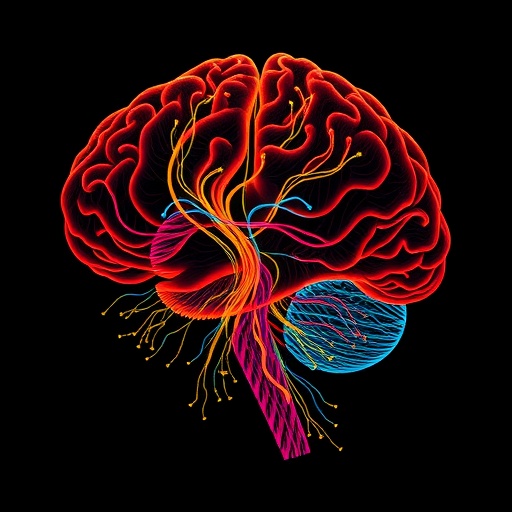In a groundbreaking study poised to redefine our understanding of brain development, a team of neuroscientists led by Sydnor, Bagautdinova, Larsen, and colleagues has unveiled new insights into how human thalamocortical structural connectivity emerges in tandem with a hierarchical axis of cortical plasticity. Published in Nature Neuroscience in 2025, this research charts uncharted territory by integrating structural neuroimaging, developmental neurobiology, and advanced computational modeling to decode the intricate dialogue between the thalamus and the cerebral cortex during human maturation.
At the core of this investigation lies the thalamus, a vital subcortical relay station that orchestrates sensory information flow and neural signals pivotal to cognition. The cerebral cortex, responsible for higher-order functions such as perception, memory, and decision-making, relies heavily on thalamic inputs to fine-tune its operational architecture. Yet, how exactly the structural wiring between these two indispensable brain regions evolves over the course of human development — and how such evolution correlates with the brain’s inherent plasticity gradients — has remained an elusive puzzle until now.
Leveraging a cohort of developing human subjects alongside sophisticated diffusion MRI tractography techniques, the researchers meticulously reconstructed thalamocortical pathways with unprecedented resolution. This allowed them to chart how these pathways strengthen, diversify, and spatially reorganize alongside cortical regions exhibiting variable degrees of plasticity. Plasticity here refers to the brain’s remarkable capacity to reorganize neural circuits in response to experience, learning, and environmental stimuli, which is known to vary hierarchically from primary sensory to higher associative cortical areas.
.adsslot_KY04hg2Dq6{width:728px !important;height:90px !important;}
@media(max-width:1199px){ .adsslot_KY04hg2Dq6{width:468px !important;height:60px !important;}
}
@media(max-width:767px){ .adsslot_KY04hg2Dq6{width:320px !important;height:50px !important;}
}
ADVERTISEMENT
One of the most compelling revelations from this work is the discovery that thalamocortical connectivity does not mature uniformly across the cortex. Instead, it develops progressively along a hierarchical axis that mirrors the known gradients of cortical plasticity. Early-maturing sensory regions, characterized by high plasticity during critical periods, exhibited robust and early-established thalamic connections. In contrast, association and prefrontal cortices demonstrated a protracted and more flexible timeline, suggesting a dynamic interplay between structural connectivity and prolonged functional refinement driven by plasticity mechanisms.
This hierarchical maturation pattern challenges previously held notions that thalamocortical pathways arise from simplified developmental blueprints. Instead, it highlights a dynamic developmental choreography, wherein the thalamic inputs scaffold the emergence of plastic cortical areas in a manner tightly linked to sensory processing demands and cognitive maturation. Such findings provide a neurobiological substrate to explain why early sensory experiences have a disproportionately large influence on brain wiring compared to experiences later in life.
The study also delves deeply into the molecular and cellular correlates underpinning this connectivity evolution. By synthesizing transcriptomic data with imaging findings, the authors identified gene expression profiles that progressively shift along the hierarchical plasticity axis. Genes implicated in synaptic growth, axonal guidance, and neurotrophic signaling were found to correlate strongly with the maturation of thalamocortical fibers, underscoring the tight coupling between molecular orchestrators and large-scale structural changes.
Beyond typical neurodevelopmental insights, the findings have broad implications for understanding critical periods of heightened plasticity and learning in human life. The thalamus, often viewed as a relay node, emerges from this research as a dynamic architect in the temporal unfolding of functional brain architecture. Modulating thalamocortical connectivity during key maturational windows may open therapeutic avenues for conditions such as autism spectrum disorder, schizophrenia, and epilepsy, where aberrant connectivity patterns disrupt normal brain function.
Intriguingly, the authors discuss how environmental influences, including sensory deprivation or enriched learning environments, might modulate this hierarchical connectivity. The plastic nature of cortical regions indicates a lasting window wherein experiential factors can reshape thalamic input, potentially enhancing or impairing cognitive resilience. This underscores the profound interaction between genetics, brain structure, and lived experience in sculpting individual developmental pathways.
Furthermore, this research offers a compelling model for evolutionary neuroscience. The hierarchical gradient of plasticity and connectivity organization may reflect a conserved principle across primates and mammals, positioning the thalamus as a central player in enabling complex cognitive flexibility. Such an axis could explain how human brains have evolved to balance stability in lower-order sensory processing with adaptability in higher-order cognition.
The integration of diverse datasets and analytical frameworks reflects a paradigm shift in neuroscience toward multidimensional brain mapping. By combining structural imaging, molecular biology, and computational modeling, the study exemplifies how holistic approaches can illuminate fundamental principles governing brain development. This comprehensive perspective is essential for bridging gaps between microscopic neural dynamics and macroscopic cognitive functions.
The implications extend to artificial intelligence and neuroengineering as well. Understanding the natural hierarchical organization of thalamocortical connectivity could inspire novel architectures for neuromorphic computing systems that mimic developmental plasticity principles. Such bioinspired designs promise advances in machine learning algorithms that adapt and restructure in response to experience, mirroring human brain maturation.
Moreover, the work raises provocative questions about how aging and neurodegenerative diseases might inversely impact this hierarchical connectivity. If the developmental axis orchestrates optimal functional maturation, its perturbation later in life could underlie cognitive decline, suggesting new biomarkers for early disease detection and intervention strategies targeting thalamocortical circuitry.
The interdisciplinary nature of this study is a testament to the collaborative spirit driving contemporary neuroscience. Contributions span fields from developmental neurobiology and cognitive neuroscience to bioinformatics and clinical neurology. This collective effort not only advances basic science but also paves the way for translational applications aimed at improving lifelong brain health.
In essence, Sydnor and colleagues offer a transformative map of how human brain connectivity evolves — revealing that the symphony between thalamus and cortex follows a hierarchical script aligned with cortical plasticity gradients. This harmonious developmental interplay orchestrates the emergence of complex cognitive abilities and holds keys to unlocking treatments for brain disorders rooted in connectivity disruptions.
As we stand on the frontier of decoding the developing human brain, this seminal study shines a light on the architectural underpinnings of cognition, learning, and adaptation. It invites a reexamination of longstanding neurodevelopmental theories and sets the stage for a future where personalized neural connectivity profiles inform education, medicine, and artificial intelligence.
Subject of Research: Human thalamocortical structural connectivity development and its relationship with hierarchical cortical plasticity
Article Title: Human thalamocortical structural connectivity develops in line with a hierarchical axis of cortical plasticity
Article References:
Sydnor, V.J., Bagautdinova, J., Larsen, B. et al. Human thalamocortical structural connectivity develops in line with a hierarchical axis of cortical plasticity.
Nat Neurosci (2025). https://doi.org/10.1038/s41593-025-01991-6
Image Credits: AI Generated
Tags: advanced neuroimaging techniques in neurosciencecognitive functions and thalamic inputscortical plasticity in brain developmentdevelopmental neurobiology of the human braindiffusion MRI tractography applicationshierarchy of cortical functions and plasticityneural connectivity and maturationresearch on brain maturation mechanismssensory information processing in the brainthalamocortical structural connectivitythalamus and cerebral cortex interactionunderstanding structural wiring in human development





